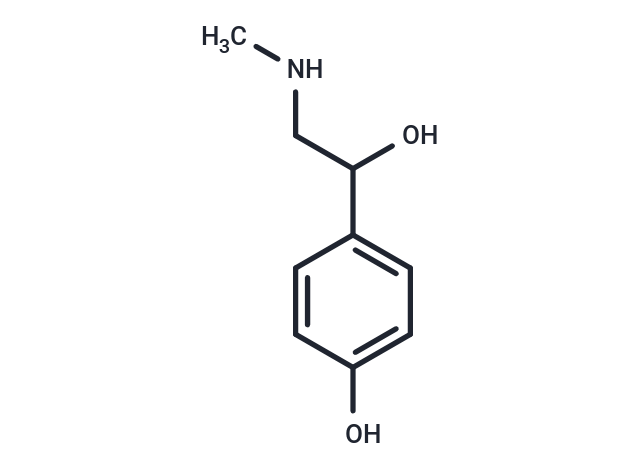Shopping Cart
Remove All Your shopping cart is currently empty
Your shopping cart is currently empty
Synephrine (Oxedrine) is sympathetic alpha-adrenergic agonist used as a vasoconstrictor in circulatory failure, asthma, nasal congestion, and glaucoma.

| Pack Size | Price | USA Warehouse | Global Warehouse | Quantity |
|---|---|---|---|---|
| 10 mg | $30 | In Stock | In Stock | |
| 25 mg | $53 | In Stock | In Stock | |
| 50 mg | $81 | In Stock | In Stock | |
| 100 mg | $113 | In Stock | In Stock | |
| 500 mg | $228 | In Stock | In Stock | |
| 1 mL x 10 mM (in DMSO) | $29 | In Stock | In Stock |
| Description | Synephrine (Oxedrine) is sympathetic alpha-adrenergic agonist used as a vasoconstrictor in circulatory failure, asthma, nasal congestion, and glaucoma. |
| In vitro | Synephrine is a compound commonly used for weight loss. Synephrine has gained significant popularity as an alternative to ephedrine. Products containing bitter orange or synephrine are suspected of causing adverse cardiovascular reactions. [1] [2] Synephrine can stimulate glucose consumption (Glut4-dependent glucose uptake) by stimulating AMPK activity, regardless of insulin-stimulated PI3 kinase-Akt activity in L6 skeletal muscle cells. [3] |
| In vivo | LD50: Mice >1000 mg/kg (s.c.) [4] |
| Synonyms | Oxedrine |
| Molecular Weight | 167.21 |
| Formula | C9H13NO2 |
| Cas No. | 94-07-5 |
| Smiles | CNCC(O)c1ccc(O)cc1 |
| Relative Density. | 1.159g/cm3 |
| Storage | Powder: -20°C for 3 years | In solvent: -80°C for 1 year | Shipping with blue ice/Shipping at ambient temperature. | ||||||||||||||||||||||||||||||||||||||||
| Solubility Information | Ethanol: 2 mg/mL (11.96 mM), Heating is recommended. DMSO: 85 mg/mL (508.34 mM), Sonication is recommended. | ||||||||||||||||||||||||||||||||||||||||
| In Vivo Formulation | 10% DMSO+40% PEG300+5% Tween 80+45% Saline: 3.3 mg/mL (19.74 mM), Sonication is recommended. Please add the solvents sequentially, clarifying the solution as much as possible before adding the next one. Dissolve by heating and/or sonication if necessary. Working solution is recommended to be prepared and used immediately. The formulation provided above is for reference purposes only. In vivo formulations may vary and should be modified based on specific experimental conditions. | ||||||||||||||||||||||||||||||||||||||||
Solution Preparation Table | |||||||||||||||||||||||||||||||||||||||||
Ethanol/DMSO
DMSO
| |||||||||||||||||||||||||||||||||||||||||
| Size | Quantity | Unit Price | Amount | Operation |
|---|

Copyright © 2015-2025 TargetMol Chemicals Inc. All Rights Reserved.